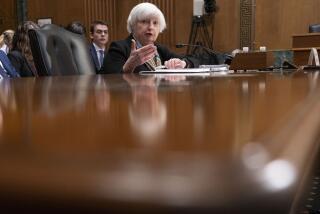Bank Regulator Backs Bush Plan--With Caveat : Seidman Ties Viability to Rate Decline, Holding Down Number of Insolvencies
- Share via
WASHINGTON — The Bush Administration’s plan to bail out the savings and loan industry is large enough to salvage all of the nation’s currently insolvent S&Ls;, but it may fall short if another 300 shaky institutions cannot survive, federal banking regulator L. William Seidman said Tuesday.
Seidman, chairman of the Federal Deposit Insurance Corp., also acknowledged that the financing costs of the bailout could soar far above the Administration’s estimate unless interest rates fall sharply from current levels.
The White House, assuming that interest rates on long-term bonds will tumble from slightly more than 9% now to an average of just 5.5% next year, estimates the 30-year expense of the plan at about $175 billion.
But Seidman released a chart showing that financing the bailout could cost as much as $250 billion to $300 billion if interest rates average 8% over the next few years and $300 billion to $350 billion if they average 10%.
Seidman was careful to distinguish the price of paying off all depositors in insolvent thrifts from the borrowing costs associated with the Bush plan. He said his estimate of the price of meeting the government’s commitment to make good on deposits of up to $100,000 was “in the same range as the Treasury Department’s estimated cost.”
Despite minor quibbles, Seidman endorsed Bush’s S&L; rescue plan as “a sound, constructive and farsighted proposal that should be enacted.”
FDIC’s latest estimates, Seidman said, show that the cost of paying off depositors at 547 insolvent thrifts--208 that were taken over by the federal government last year and 339 remaining insolvent institutions--would be $67.3 billion to $74.9 billion.
The Treasury Department’s comparable estimate is $90 billion, but that also covers the cost of meeting the government’s insurance commitment at an unspecified share of marginally solvent thrift institutions.
Another 120 S&Ls; remain barely solvent--their assets still exceed their liabilities--only because they are allowed to include goodwill and certain intangible assets on their balance sheets. An additional 154 thrifts are marginally solvent but currently unprofitable.
If the federal government were forced to take over the additional 274 thrift institutions at risk of going under, it would probably cost $92 billion to $111.6 billion to pay off their depositors, FDIC estimated.
The estimates are imprecise because regulators do not know whether all of the residential mortgages and mortgage securities held by the sick thrifts are still good or whether some must be written off.
Seidman, like Federal Reserve Chairman Alan Greenspan, questioned whether there is a need for a separate thrift industry to finance housing. But as long as thrifts continue to operate, he said, they should be limited in their role.
More to Read
Sign up for Essential California
The most important California stories and recommendations in your inbox every morning.
You may occasionally receive promotional content from the Los Angeles Times.













